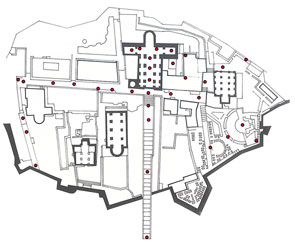 Archaeological Museum and
Virtual Visit to 360 degrees of the Lipari's acropolis
Archaeological Museum and
Virtual Visit to 360 degrees of the Lipari's acropolis

Virtual Visit to 360 degrees of the Lipari's acropolis
The
archaeological museum of Lipari
Section I.
It is located in the palace of the bishops, adjacent to the
cathedral, construction of the seventeenth century.
Materials excavation of the Acropolis Lipari
ROOM I - The exhibit materials of the two
phases of the oldest Aeolian's Neolithic
ROOM II - Materials of the third and fourth
phase of the Aeolian's Neolithic
ROOM III -Materials of the fourth stage
of the Aeolian's Neolithic .
ROOM IV - Aeolian's Neolithic.
ROOM V - Recent Aeolian's Neolithic .
ROOM VI - first age of bronze: Culture of Cape
Graziano; middle age of Bronze: Culture "Milazzese" (from
Milazzo). Ceramics local imports Aegean.
FLOOR BELOW
ROOM VII - Late age of bronze. First phase of
culture Ausonia (1250-1150 BC)
ROOM VIII - finish age of bronze -Second phase
culture Ausonia (1150-850 BC).
ROOM IX - end of the second period of
civilization Ausonia (late ninth century BC). The village
dell'Ausonio II underwent a violent destruction. The huts
burned (evident in the excavation traces of fire) collapsed
burying all masserizie that contained. One has the
impression that after the destruction this village not being
rebuilt.
ROOM X - Greek and Roman civilization in the
urban area of Lipari. From ROOM X
, a wall of which is made up of the remains of the
Norman building blocks built with Greek riused, which rises
in the garden below, where other remains of the palace and
visit:
ROOM XI - epigraphic hall (there are collected
and entered stems from the tombs of the necropolis of Lipari
from the fifth century. BC to the Roman).
Section II
It is located in front of the bishop's palace (room
XII-XV) with archaeological island of Panarea, Filicudi,
Alicudi, Salina, Stromboli.
Section III, Section IV and
Section V
They are located in another building north of the cathedral
with the necropolis and proto-classic Lipari, the prehistory
and proto Milazzo, and marine archeology. They are so
divided
Bottom left:
ROOMS XVI and XVII - Archaeological Materials
from Milazzo.
ROOM XVI (at the bottom) - Necropolis of the
middle age of bronze found in the village Sottocastello (XIV-XIII
sec. BC). Necropolis was rebuilt exactly as it was found
during excavations in May 1952. Only some of the graves on
the margins were very close to the main group.
ROOM XVII - Necropolis protovillanoviana (XII-XI
century BC) and necropolis protogreca (716-580 about BC)
discovered around the square Rome and via XX September.
Bottom right:
ROOM XVIII - has been faithfully rebuilt the
necropolis early dell'Ausonio II in Lipari found in
excavations of Monfalcone Piazzetta, in the center of the
modern city, in 1953.
ROOM XIX - are exposed main types of
sarcophagi, vases cinerari, large jars containing the
accompanying funerary cippi and stems of the great Greek and
Roman necropolis of Lipari.
HIGHER LEVEL
ROOMS XX-XXV -Necropolis Greek and Roman in
the country Diana Lipari. The excavations of Greek and Roman
necropolis of Lipari exploring about 2500 graves, brought to
the Aeolian Museum a large number of works of art,
especially ceramics and terracotta figures. The first graves
are just after the founding of the Greek colony (580 BC).
The graves that have richer outfits are those of the fourth
century BC. In the first half of this century belongs crater
with a representation of an episode dell'Odissea. Ulysses,
arrived at the home of Ciconi receives from Maron, a priest
of Apollo, goatskin wine, which will drink the Cyclops
Polyphemus.
In the second half of the fourth century, flourishes in
Lipari a local school ceramics. Characteristic of this
school is the wide use of polychromy, which for favorable
ground conditions, it is often very well preserved. In
Lipari half of the fourth century BC Thrive, a lively
coroplastica which draws its themes from contemporary
theater. It is a remarkable testimony series of clay model
of theatrical masks of this age.
ROOM XXIV is exposed result of the excavations
carried out at a small shrine dedicated to Demeter and Kore
dug in the village Diana.
In ROOM XXV is rebuilt a group of tombs of the
necropolis. With its polychrome ceramics and its
coroplastica Lipari is in the fourth century. BC One of the
most vivid art and individual Greece of the West and to some
extent spiritually closest that southern Italy to Sicily.
Returning to the ground floor, before exiting, take a look
at the ROOM XXVI Hall marine archeology.
The exhibit materials from
Undersea Research carried out over the last thirty years of
the the AeolianIslands.
Of interest are the
exceptional prehistoric pottery style Cape Graziano I (XVII-XVI
sec. BC) recovered in the bay of Lipari. In just over a
recent amphora fragment of a Mycenaean age bracket (XVI-XV
sec.aC).
Anfore from wrecks IV sec. BC
Graziano, head of Filicudi and the fourth century. BC The
Ants of Panarea.
Great complex ceramic amphorae
and painted black (IV-III sec. BC) from a cargo ship sank at
the Head of Filicudi Graziano.
Great complex ceramic amphorae
and painted black (Bell) who were loading a ship oneraria
sank at the dry Lipari (half sec.aC III).
Great complex ceramic amphorae
and painted black (Campana B) by loading a ship oneraria
sank at the Head of Filicudi Graziano (half III BC).
Anfore old imperial Roman other wreck at Filicudi.
Cannons bronze vessel of the late seventeenth and early
eighteenth century whose wreck was superimposed on those of
Greek ships of Filicudi.
In the park surrounding the museum were rebuilt different
types of tombs from the fourth century Fr. BC Necropolis
found in the village of Diana.
The Room
Geological - VULCANOLOGICal of the Museum Eoliano
illustrates through charts, models and captions geological
history of the Aeolian islands and various episodes through
which they have made their appearance today.